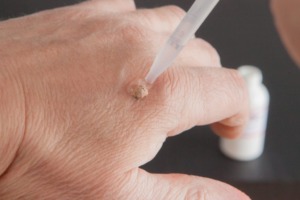
Think twice before you inject salicylic acid into your wart
At first blush, it might seem like a reasonable idea to inject salicylic acid wart medicine directly into your wart. Wouldn’t doing so, the thinking goes, make the wart disappear twice as fast? Injecting it into the meaty core of the wart and applying it directly to the outer skin of the wart at the same time would seem to burn through the wart from both directions.
To date, salicylic acid treatments have only been approved for topical application on warts, not for injection. Why is that? In theory, the idea of injection seems to make sense. But there are a few reasons why injecting salicylic acid is not really a good idea in practice:
Inside your wart are many tiny blood vessels that carry oxygen and nutrients to the flesh of the wart. If you inject salicylic acid into it, there is the risk that some of the acid will be injected directly into your bloodstream. Salicylic acid is a powerful compound that kills skin cells on contact. Obviously, you do not want this substance to enter your blood vessels and cardiovascular system.
Salicylic acid itself makes up only about 25% of a typical wart medication. The other inactive ingredients were formulated only for topical and not internal use. Injecting these chemicals into your body will have unpredictable and possibly dangerous outcomes.
Secondly, injecting salicylic acid into a wart is going to be more painful than applying it to the surface of the wart. The outer skin of a wart hardens into a protective shell, while the inside of the wart contains soft tissue, blood vessels, and nerve endings.
Did you ever notice how much more it hurts to apply salicylic acid to a wet or bloody wart, after the tough outer core has been burned away? Injecting salicylic acid directly into these soft tissues is going to hurt.
Finally, using salicylic acid only on the surface of a wart allows you to slowly and safely shave down the wart. In this way, the healthy skin tissue under the wart is better protected. You can stop applying salicylic acid when you visually see that the wart is completely removed. If you inject salicylic acid, there is a greater risk that healthy skin tissue will be burned away as well.
How to properly remove a wart with topical application of salicylic acid
Rather than injecting your wart with salicylic acid, be safe and follow the intended use. Clean the wart with soap and soak it in water for 15 to 30 minutes to soften up the skin. Dry and remove water from the surface of the wart. Apply salicylic acid wart medication to the entire exposed surface of the wart.
Allow the salicylic acid to harden and dry, and then cover with gauze. You may apply salicylic acid up to twice a day. In between applications, use an emery board or nail file to shave off the dead skin cells of the wart. Length of treatment time required to remove it depends on the size and type of wart.
Salicylic acid is successful on about 70% of all warts. If topical salicylic acid treatment is not successful at removing your wart, please see a dermatologist to have it professionally removed rather than injecting it yourself with salicylic acid.
Do you have experience with injecting a wart with salicylic acid?
I would like to know in the comments if you have ever injected your wart with salicylic acid. What was your experience like? Was it painful? Would you recommend it? Please let us know.
OTC Medicine for Wart Removal
 |  |  |  |
| Wart Remover Pads/Adhesives | Liquid Wart Remover | Wart Freeze Off | Wart Removal Pen |


Leave a Reply